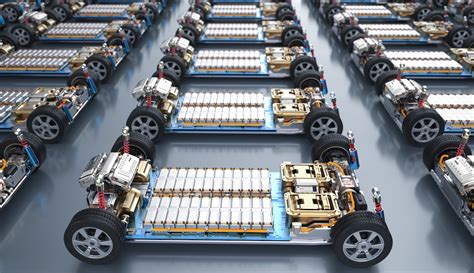
The growing number of electric vehicle (EV) batteries reaching the end of their lifespan presents a looming environmental challenge, but experts are urging against landfilling them, advocating instead for widespread reuse and recycling initiatives. As the EV market expands, the disposal of spent batteries is becoming an increasingly pressing issue, with concerns over resource depletion and potential ecological harm if not handled correctly.
The rise of electric vehicles has brought immense benefits, reducing carbon emissions and improving air quality. However, the lifecycle of EV batteries—from raw material extraction to eventual disposal—demands careful consideration. “We’re going to have thousands of tons of batteries that need to be dealt with, and that number is just going to keep growing,” said Steven Tritschler, Program Manager at Argonne National Laboratory, highlighting the urgency of the situation.
Experts believe that a circular economy approach, focusing on reuse and recycling, is essential to mitigating the environmental impact and maximizing the value of the materials contained within these batteries. The critical components like lithium, cobalt, and nickel are valuable and can be recovered and repurposed in new batteries or other applications, reducing the need for further mining and resource extraction.
The Looming EV Battery Waste Problem
As electric vehicles become increasingly mainstream, the question of what to do with their batteries once they reach the end of their useful life is becoming more urgent. The lifespan of an EV battery typically ranges from 5 to 10 years, depending on usage, driving conditions, and battery chemistry. As early adopters of EVs begin to replace their vehicles, a wave of spent batteries is entering the waste stream, and this trend is only expected to accelerate in the coming years.
The sheer volume of EV batteries that will need to be managed is staggering. According to Tritschler, “thousands of tons of batteries” will require proper handling, and this quantity will continue to increase as EV adoption grows. The concern is that if these batteries are simply landfilled, valuable resources will be lost, and there is a risk of environmental contamination from the hazardous materials they contain.
Why Landfilling is Not the Answer
Landfilling EV batteries is not a sustainable solution for several reasons:
- Resource Depletion: EV batteries contain valuable materials such as lithium, cobalt, nickel, and manganese. These materials are finite resources, and extracting them from the earth can have significant environmental consequences. Landfilling batteries means losing the opportunity to recover and reuse these materials, further exacerbating resource depletion.
- Environmental Contamination: EV batteries contain electrolytes and other chemical compounds that can be harmful to the environment if they leak into the soil or groundwater. Landfilling increases the risk of such leaks, potentially contaminating ecosystems and posing risks to human health.
- Safety Hazards: Damaged or improperly handled EV batteries can pose safety hazards. They can catch fire or explode, releasing toxic fumes and causing environmental damage. Landfilling increases the risk of such incidents.
- Economic Loss: Disposing of EV batteries in landfills represents a significant economic loss. The materials contained within these batteries have substantial value and can be sold or reused, generating revenue and creating jobs. Landfilling means foregoing these economic opportunities.
The Case for Reuse: Extending Battery Life
One of the most promising strategies for addressing the EV battery waste problem is reuse. Rather than immediately recycling batteries that have reached the end of their useful life in vehicles, they can be repurposed for other applications.
- Second-Life Applications: EV batteries that no longer meet the performance demands of vehicles can still be used for less demanding applications, such as energy storage systems for homes, businesses, or the electric grid. These “second-life” applications can extend the lifespan of EV batteries by several years, delaying the need for recycling and maximizing their value.
- Grid Stabilization: Repurposed EV batteries can be used to provide grid stabilization services, such as frequency regulation and peak shaving. This helps to improve the reliability and efficiency of the electric grid, supporting the integration of renewable energy sources.
- Backup Power: Second-life EV batteries can also be used as backup power systems for homes, businesses, and critical infrastructure. This provides a reliable source of electricity during power outages, enhancing resilience and security.
According to the original article, the feasibility of reuse depends on several factors, including the condition of the battery, the cost of repurposing it, and the demand for second-life applications. However, with proper planning and investment, reuse can play a significant role in reducing EV battery waste.
The Importance of Recycling: Recovering Valuable Materials
While reuse can extend the lifespan of EV batteries, eventually they will need to be recycled. Recycling involves breaking down the batteries and recovering the valuable materials they contain, such as lithium, cobalt, nickel, and manganese.
- Hydrometallurgy: This process involves using chemical solvents to dissolve the battery materials and then selectively extracting the desired elements. Hydrometallurgy can recover a wide range of materials, but it can also be energy-intensive and generate hazardous waste.
- Pyrometallurgy: This process involves heating the batteries to high temperatures to melt the materials and separate them based on their density. Pyrometallurgy is less energy-intensive than hydrometallurgy, but it may not be able to recover all of the valuable materials.
- Direct Recycling: This emerging technology aims to directly recover the battery materials without breaking them down into their constituent elements. Direct recycling has the potential to be more efficient and environmentally friendly than traditional recycling methods, but it is still in the early stages of development.
The choice of recycling method depends on several factors, including the type of battery, the desired purity of the recovered materials, and the cost of the process. However, regardless of the method used, recycling is essential for closing the loop and ensuring that valuable resources are not lost.
Challenges and Opportunities in EV Battery Recycling
While EV battery recycling offers significant benefits, it also faces several challenges:
- Cost: Recycling EV batteries can be expensive, particularly compared to landfilling. The cost of collecting, transporting, and processing the batteries can be significant, and the recovered materials may not always be valuable enough to offset these costs.
- Technology: EV battery recycling technology is still evolving, and there is no single “best” method. Different recycling processes have different advantages and disadvantages, and the optimal approach may vary depending on the type of battery and the desired outcomes.
- Infrastructure: The infrastructure for recycling EV batteries is still limited in many parts of the world. There are not enough recycling facilities to handle the growing volume of spent batteries, and the transportation networks for collecting and delivering batteries to these facilities are often inadequate.
- Regulation: Regulations governing EV battery recycling vary widely from country to country and even from state to state. This can create uncertainty for recyclers and make it difficult to establish a consistent and efficient recycling system.
Despite these challenges, there are also significant opportunities in EV battery recycling:
- Growing Market: The market for recycled battery materials is expected to grow rapidly in the coming years as the demand for EV batteries increases. This will create new economic opportunities for recyclers and incentivize investment in recycling infrastructure.
- Technological Innovation: Ongoing research and development efforts are leading to more efficient and cost-effective recycling technologies. These innovations will help to overcome the challenges facing the industry and make recycling more economically viable.
- Government Support: Governments around the world are increasingly recognizing the importance of EV battery recycling and are providing financial incentives and regulatory support to promote its development. This support will help to accelerate the growth of the industry and ensure that it plays a key role in the transition to a sustainable energy future.
The Role of Policy and Regulation
Effective policies and regulations are crucial for promoting EV battery reuse and recycling. These policies should address several key areas:
- Extended Producer Responsibility (EPR): EPR policies hold manufacturers responsible for the end-of-life management of their products. This can incentivize manufacturers to design batteries that are easier to reuse and recycle, and to invest in recycling infrastructure.
- Recycling Mandates: Recycling mandates require a certain percentage of EV batteries to be recycled. This can help to ensure that batteries are not simply landfilled and that valuable materials are recovered.
- Standards and Certifications: Standards and certifications can help to ensure that EV batteries are reused and recycled safely and responsibly. These standards can cover aspects such as battery handling, storage, and processing.
- Incentives for Reuse and Recycling: Financial incentives, such as tax credits and subsidies, can help to make reuse and recycling more economically attractive. This can encourage businesses and consumers to participate in these activities.
Consumer Awareness and Education
Raising consumer awareness about the importance of EV battery reuse and recycling is also essential. Consumers need to understand the environmental and economic benefits of these activities, and they need to know how to properly dispose of their EV batteries.
- Public Education Campaigns: Public education campaigns can help to raise awareness about EV battery reuse and recycling. These campaigns can use various media channels, such as television, radio, and social media, to reach a wide audience.
- Labeling and Information: EV batteries should be clearly labeled with information about their composition, hazards, and proper disposal methods. This will help consumers to make informed decisions about how to manage their batteries.
- Collection Programs: Convenient collection programs can make it easier for consumers to recycle their EV batteries. These programs can include drop-off locations, mail-back programs, and curbside collection services.
The Path Forward: A Circular Economy for EV Batteries
The key to addressing the EV battery waste problem is to transition to a circular economy model, where batteries are reused and recycled to the greatest extent possible. This requires a collaborative effort involving manufacturers, recyclers, policymakers, and consumers.
- Design for Reuse and Recycling: Manufacturers should design EV batteries that are easy to disassemble, reuse, and recycle. This can involve using fewer hazardous materials, simplifying the battery architecture, and developing standardized battery modules.
- Investment in Recycling Infrastructure: Significant investment is needed to build and expand EV battery recycling infrastructure. This includes constructing new recycling facilities, upgrading existing facilities, and developing efficient transportation networks.
- Support for Research and Development: Continued research and development efforts are needed to improve EV battery recycling technologies and make them more cost-effective. This includes exploring new recycling methods, optimizing existing methods, and developing innovative battery designs.
- Collaboration and Partnerships: Collaboration and partnerships among manufacturers, recyclers, policymakers, and consumers are essential for creating a successful EV battery circular economy. This can involve sharing information, coordinating activities, and developing joint solutions.
Conclusion
The looming EV battery waste problem presents a significant environmental and economic challenge, but it also offers a tremendous opportunity to create a more sustainable and circular economy. By prioritizing reuse and recycling, we can reduce resource depletion, minimize environmental contamination, and create new economic opportunities. However, realizing this vision requires a concerted effort involving all stakeholders, from manufacturers and recyclers to policymakers and consumers. Through innovation, collaboration, and a commitment to sustainability, we can ensure that EV batteries contribute to a cleaner and more prosperous future. As Steven Tritschler said, addressing this issue proactively is essential to avoid a future “mountain” of discarded batteries.
Frequently Asked Questions (FAQ)
-
What happens to EV batteries at the end of their life?
EV batteries that have reached the end of their useful life in vehicles can either be reused for second-life applications or recycled to recover valuable materials. Landfilling is discouraged due to environmental concerns and resource depletion.
-
What are second-life applications for EV batteries?
Second-life applications include using EV batteries for energy storage systems in homes, businesses, or the electric grid, providing grid stabilization services, and serving as backup power systems.
-
Why is recycling EV batteries important?
Recycling EV batteries is important because it allows for the recovery of valuable materials like lithium, cobalt, and nickel, reducing the need for further mining and resource extraction, and minimizing the risk of environmental contamination.
-
What are the main challenges in EV battery recycling?
The main challenges include the high cost of recycling, the evolving nature of recycling technology, limited recycling infrastructure, and varying regulations.
-
What role do consumers play in EV battery recycling?
Consumers play a crucial role by properly disposing of their EV batteries through designated collection programs and by supporting policies that promote reuse and recycling. Consumer awareness and participation are essential for a successful circular economy for EV batteries.
Detailed Analysis of Recycling Technologies and Processes
To fully understand the complexities and possibilities surrounding EV battery recycling, a more in-depth look at the various recycling technologies and processes is necessary. Each method has its own set of advantages, disadvantages, and environmental implications.
1. Hydrometallurgy: The Chemical Approach
- Process Overview: Hydrometallurgy involves using aqueous solutions to dissolve the battery components and then selectively recover the desired metals through chemical precipitation, solvent extraction, and ion exchange.
- Advantages:
- High Recovery Rates: Hydrometallurgical processes can achieve high recovery rates for a wide range of valuable metals, including lithium, cobalt, nickel, and manganese.
- Versatility: It can handle different battery chemistries and compositions.
- High Purity: The recovered metals can achieve high purity levels, making them suitable for use in new batteries or other high-value applications.
- Disadvantages:
- Energy Intensive: The process can be energy-intensive, requiring significant amounts of heat and electricity.
- Chemical Use: It uses large volumes of chemicals, some of which can be hazardous if not handled properly.
- Waste Generation: Hydrometallurgy generates liquid and solid waste streams that require treatment and disposal.
- Environmental Impact: The environmental impact of hydrometallurgy depends on the specific chemicals used and the effectiveness of the waste treatment processes. Improperly managed hydrometallurgical processes can lead to water and soil contamination.
2. Pyrometallurgy: The High-Temperature Route
- Process Overview: Pyrometallurgy involves heating the batteries to high temperatures (typically above 1000°C) in a furnace. The metals melt and separate based on their density, allowing them to be recovered.
- Advantages:
- Simplicity: Pyrometallurgical processes are relatively simple and can handle a wide range of battery types without pre-treatment.
- Energy Efficiency: It can be less energy-intensive than hydrometallurgy, especially when using waste heat from other industrial processes.
- Volume Reduction: It effectively reduces the volume of battery waste.
- Disadvantages:
- Lower Recovery Rates: Pyrometallurgy typically has lower recovery rates than hydrometallurgy, especially for lithium and other volatile elements.
- Limited Metal Selectivity: It is difficult to selectively recover individual metals, resulting in a mixed metal product that requires further refining.
- Emissions: High-temperature processes can generate air emissions, including greenhouse gases and pollutants, which require careful control.
- Environmental Impact: The environmental impact of pyrometallurgy depends on the type of furnace used, the effectiveness of the emission control systems, and the management of slag and other waste products.
3. Direct Recycling: The Emerging Frontier
- Process Overview: Direct recycling aims to directly recover the cathode materials from EV batteries without breaking them down into their constituent elements. This can involve mechanical separation, physical processing, and chemical treatment.
- Advantages:
- High Efficiency: Direct recycling has the potential to be more energy-efficient and resource-efficient than traditional recycling methods.
- Preservation of Cathode Structure: It preserves the structure and composition of the cathode material, allowing it to be directly reused in new batteries.
- Reduced Waste: It generates less waste compared to hydrometallurgy and pyrometallurgy.
- Disadvantages:
- Technological Complexity: Direct recycling is a complex and relatively new technology that is still under development.
- Battery Chemistry Dependence: It may be limited to specific battery chemistries and designs.
- Contamination Sensitivity: The process can be sensitive to contamination, requiring careful control of the input materials.
- Environmental Impact: Direct recycling has the potential to be the most environmentally friendly recycling method, but its environmental impact will depend on the specific technologies used and the effectiveness of the process controls.
4. Emerging Technologies and Innovations
Several emerging technologies and innovations are further improving the efficiency and sustainability of EV battery recycling. These include:
- Mechanical Pre-treatment: Advanced mechanical pre-treatment processes can improve the efficiency of downstream recycling processes by separating battery components, removing contaminants, and increasing the surface area of the materials.
- Bioleaching: Bioleaching uses microorganisms to dissolve battery materials and recover valuable metals. This process can be more environmentally friendly than traditional chemical leaching methods.
- Supercritical Fluid Extraction: Supercritical fluid extraction uses supercritical fluids (such as carbon dioxide) to selectively extract metals from battery materials. This process can be more energy-efficient and less toxic than traditional solvent extraction methods.
- Plasma Technology: Plasma technology uses high-energy plasma to break down battery materials and recover valuable metals. This process can be very efficient and can handle a wide range of battery types.
Economic Considerations and Market Dynamics
The economic viability of EV battery recycling is a critical factor in its widespread adoption. The economics of recycling depend on several factors, including the cost of collection, transportation, and processing, as well as the market value of the recovered materials.
- Cost Factors:
- Collection and Transportation: Collecting and transporting spent EV batteries can be expensive, especially in remote areas.
- Pre-treatment: Pre-treatment processes, such as dismantling and shredding, can add to the cost of recycling.
- Recycling Process: The cost of the recycling process itself depends on the technology used and the scale of the operation.
- Waste Management: The cost of managing waste streams generated by the recycling process can also be significant.
- Revenue Factors:
- Recovered Material Value: The value of the recovered materials, such as lithium, cobalt, and nickel, is a key driver of the economics of recycling.
- Government Subsidies and Incentives: Government subsidies and incentives can help to make recycling more economically attractive.
- Carbon Credits: Recyclers may be able to earn carbon credits for reducing greenhouse gas emissions.
- Market Dynamics:
- Demand for Recycled Materials: The demand for recycled battery materials is expected to grow rapidly in the coming years as the demand for EV batteries increases.
- Supply of Recycled Materials: The supply of recycled battery materials is currently limited but is expected to increase as more EV batteries reach the end of their life.
- Price Fluctuations: The prices of battery materials can fluctuate significantly, affecting the profitability of recycling.
Global Regulatory Landscape and Policy Initiatives
The regulatory landscape for EV battery recycling varies significantly from country to country. Some countries have implemented comprehensive regulations, while others are still in the early stages of developing their policies.
- European Union: The European Union has implemented strict regulations on battery recycling through the Battery Directive and the upcoming Battery Regulation. These regulations set targets for recycling efficiency and material recovery and require manufacturers to take responsibility for the end-of-life management of their batteries.
- United States: The United States does not have a national battery recycling law, but several states have implemented their own regulations. California, for example, has a comprehensive battery recycling law that requires manufacturers to collect and recycle their batteries. The federal government is also supporting research and development efforts to improve EV battery recycling technologies.
- China: China is the world’s largest EV market and has implemented regulations on battery recycling. The Chinese government requires EV manufacturers to establish recycling networks and sets targets for material recovery.
- Other Countries: Many other countries around the world are developing policies and regulations to promote EV battery recycling. These policies often include extended producer responsibility schemes, recycling mandates, and financial incentives.
The Importance of Standardization and Harmonization
Standardization and harmonization of EV battery recycling regulations and practices are essential for creating a global circular economy. This can involve developing common standards for battery design, collection, transportation, and recycling.
- Battery Design Standards: Standardized battery designs can make it easier to disassemble, reuse, and recycle batteries.
- Collection and Transportation Standards: Standardized collection and transportation procedures can improve the efficiency and safety of the recycling process.
- Recycling Process Standards: Standardized recycling process can ensure that batteries are recycled in an environmentally responsible and economically efficient manner.
- Harmonized Regulations: Harmonized regulations can reduce barriers to cross-border trade and investment in recycling infrastructure.
The Role of Collaboration and Partnerships
Collaboration and partnerships among stakeholders are essential for addressing the challenges and opportunities of EV battery recycling. This includes collaboration among manufacturers, recyclers, policymakers, researchers, and consumers.
- Industry Collaboration: Collaboration among manufacturers and recyclers can lead to the development of more sustainable battery designs and recycling processes.
- Public-Private Partnerships: Public-private partnerships can leverage the expertise and resources of both the public and private sectors to develop and implement effective recycling programs.
- International Collaboration: International collaboration can facilitate the sharing of knowledge, technologies, and best practices.
Conclusion: A Call to Action for Sustainable EV Battery Management
The EV revolution is transforming the transportation landscape, but it is also creating a new set of environmental and economic challenges. The looming EV battery waste problem requires urgent action to prevent a future “mountain” of discarded batteries.
By embracing a circular economy model, we can transform this challenge into an opportunity. Prioritizing reuse and recycling, supporting technological innovation, implementing effective policies, and fostering collaboration among stakeholders are all essential steps. As Steven Tritschler emphasized, proactive measures are crucial to ensuring that EV batteries contribute to a cleaner and more sustainable future. It requires a collective effort to safeguard our environment, conserve valuable resources, and build a prosperous economy. The time to act is now.









